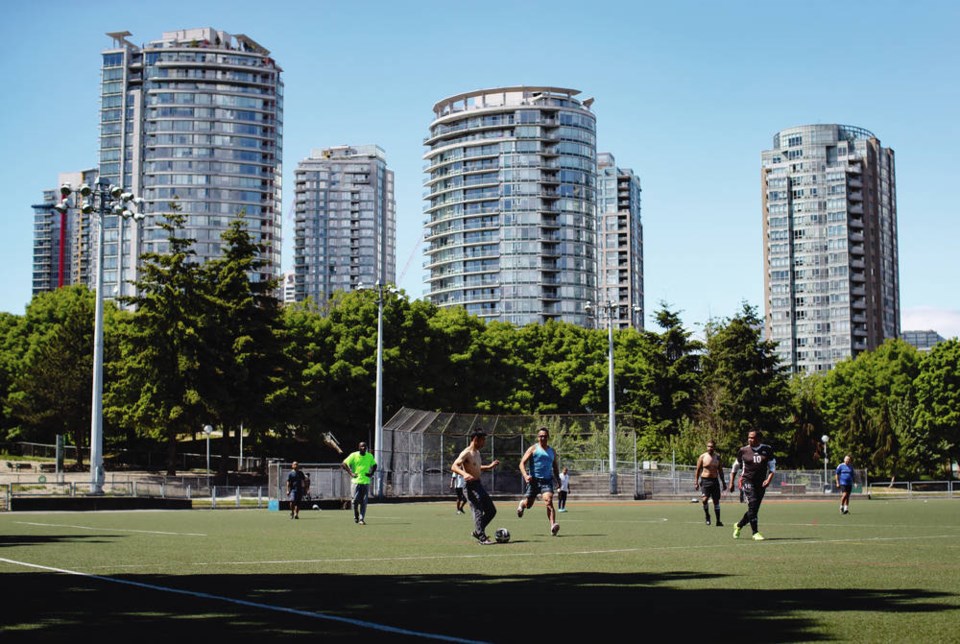The first little vacation I plan to take when we “open up” is to Vancouver. I love Vancouver and lived there, in a little beige apartment in the West End, when I first left home by train, from Fredericton, N.B., in 1978.
My first job was at the old Arts Club Theatre down on Davie Street, mostly taking care of the actors and their smoky, pungent and musky dressing rooms, but once I played the part of a manicurist. I had no lines — just filing.
Those were the days when Woodwards was booming and there was a butcher shop on lower Granville Street named “We Have Meat That Ye Can Eat” where Mum used to buy ox tails when she came to visit me (I loved ox tail soup).
Back then, it was safe for a young girl to ride a bike through the Stanley Park woodland at twilight.
Expo and the Olympics really changed Vancouver, made it sparkling and modern, cleaned it up with lush little pocket parks, speed bumps, public art, bike routes and towering turquoise and steel skyscrapers, but the old Vancouver still remains on the shady side streets and between the pot shops, high-end boutiques, shiny bike racks and SkyTrain stations. It’s a lovely blend of old and new.
It is on my list to hike up the Grouse Grind — that should really shake out the COVID cobwebs! (I’ll take the gondola down.)
The Glorious Mountains of Vancouver’s North Shore — A Peakbagger’s Guide by David Crerar, Harry Crerar, and Bill Maurer (2018, Rocky Mountain Books) describes far more than the hiking trails among those beautiful summits. This book is so jam-packed with information on history and discovery, observations, the environment, quotes (many by Pauline Johnson), photographs, maps, trivia and even poetry that the print is very small on the 400-plus pages!
For example, Grouse Mountain, once you reach the top — either by hiking or by the “Skyride” — offers several hiking options from the chalet, ranging from one kilometre to more than 12. Everything is described — elevation, when it was first ascended (the first ascent was recorded in 1894, but the book acknowledges that the First Nations were there long before), dog regulations, terrain, sun exposure, snow-free days, whether it’s appropriate for children, and must-sees such as “lumberjacks … wood sculptures … beaver tails …”
If scaling these beautiful peaks and gazing at the amazing views seems a bit much for you, I suggest the gentler nature activities noted in the lovely book Parks and Nature Places Around Vancouver, compiled by Nature Vancouver (formerly the Vancouver Natural History society), edited by Alison Parkinson (2009, Harbour Publishing).
Did you know that Vancouver has a bog on 16th Avenue? This restored sphagnum bog and pond, approximately 2,000 years old, is surrounded by a boardwalk and borders on the forested Pacific Spirit Park, which is full of woodland paths. It is a site for songbirds and unique shrubs, shore pines and flora such as the insect-eating sticky sundew.
All the locations noted in this little glossy book are easily accessible by bus, and clear directions, maps and lovely photographs are provided.
If you prefer to wander downtown and take in a wide diversity of architecture, then I suggest Exploring Vancouver: The Architectural Guide by Harold Kalman, with an introduction by former Vancouver mayor and B.C. premier Mike Harcourt (2012, Douglas and McIntyre).
The book is divided into 14 walkable routes, each with a map and an abundance of descriptions and images of an eclectic mix of structures, some iconic, some historic and some contemporary.
On your explorations, you might discover the Punjabi Market at Main and East 49th, the Vancouver Salt Company Warehouse on West 1st, which produced coarse salt used by the local fishery in the 1930s, or the Marine Building on Burrard Street, which has been called “the best art deco office building in the world.”
This lovely old stoic structure “celebrates seaborne trade and transport with a decorative scheme of astonishing variety. Terracotta trim drips with stylized sea life, ships of exploration and symbols of transportation; star signs on the floor of the lobby represent navigation …”
I strongly recommend that you visit the Dr. Sun Yat-Sen Classical Chinese Garden on Carrall Street, which is also briefly described in the book. I suggest purchasing the beautiful catalogue on the premises of this tranquil and serene traditional Ming Dynasty landscaped space of harmonious contrasts in the heart of the city.
Legacy of Trees: Purposeful Wandering in Vancouver’s Stanley Park by Nina Shroroplova (2020, Heritage House Publishing) is a delightful and informative amble amongst the diverse flora throughout this natural paradise.
The author covers a thorough history of the park, but focuses on tree identification and landscape design in numerous areas, including the three welcoming gateways of red cedar carved by First Nations artist Susan Point beside a magnificent sweetgum tree at Brockton Point, “Martha Smith’s Lilac Bushes,” “The Hollow Tree” and the commemorative ornamental cherry trees.
Planning a little getaway to reset our stimuli just might be the way to sweep away those COVID cobwebs.



